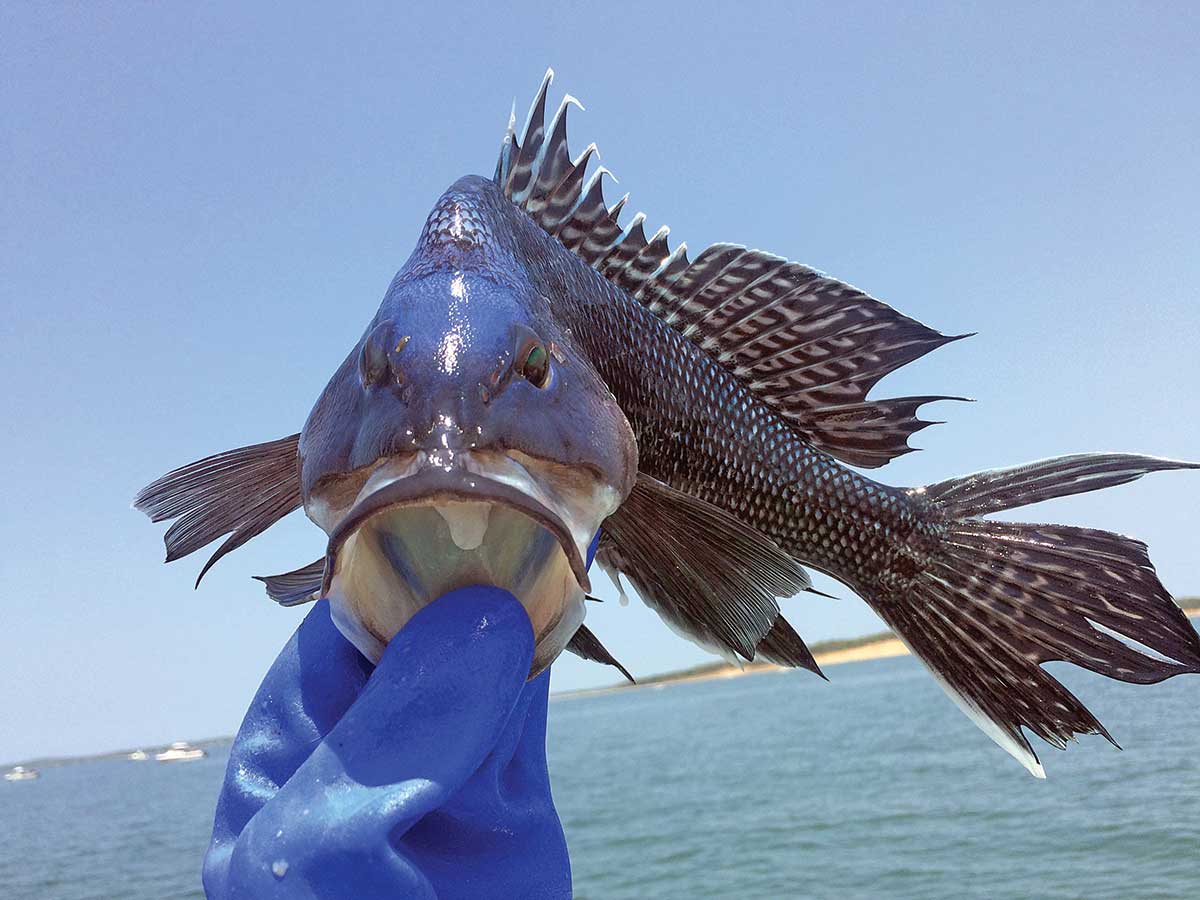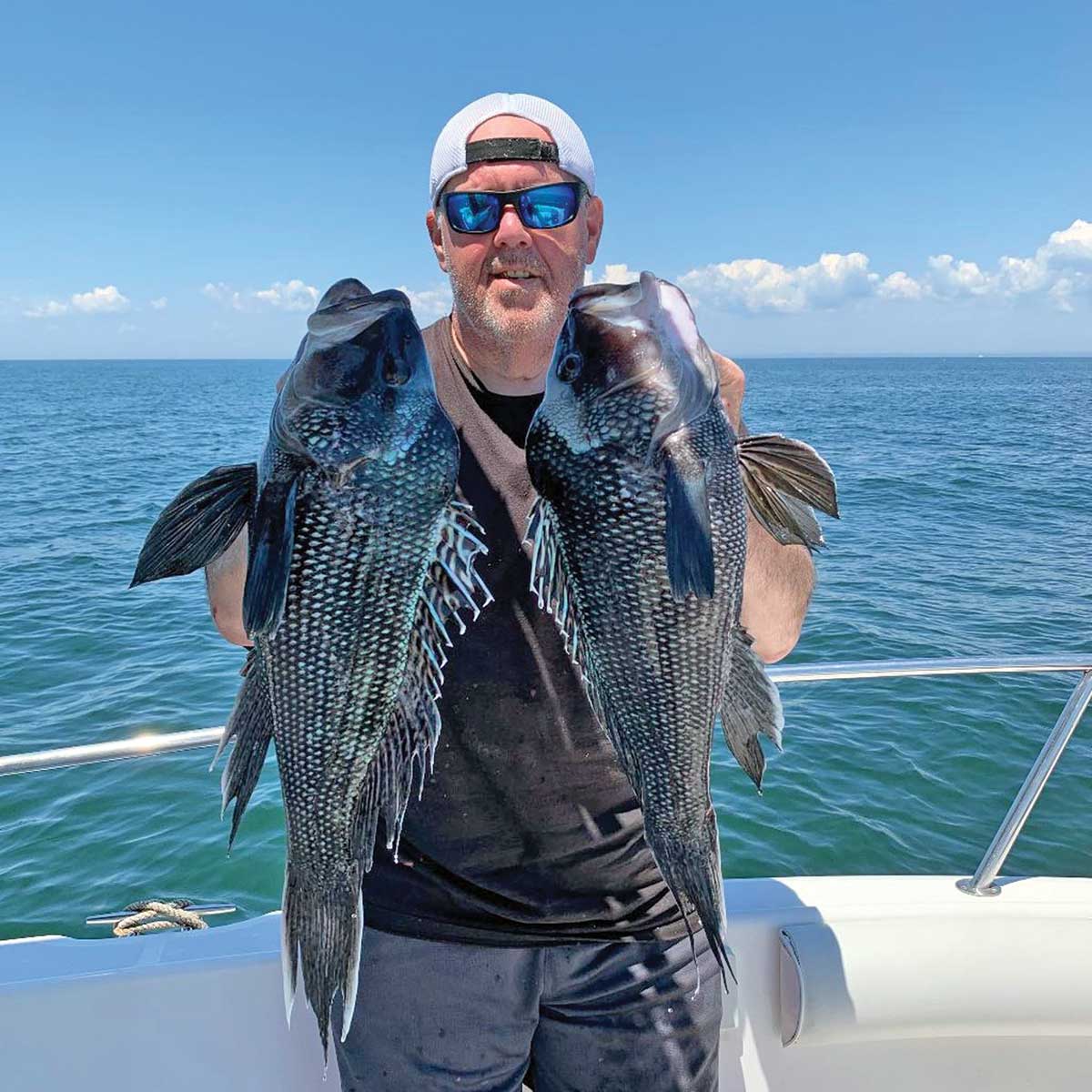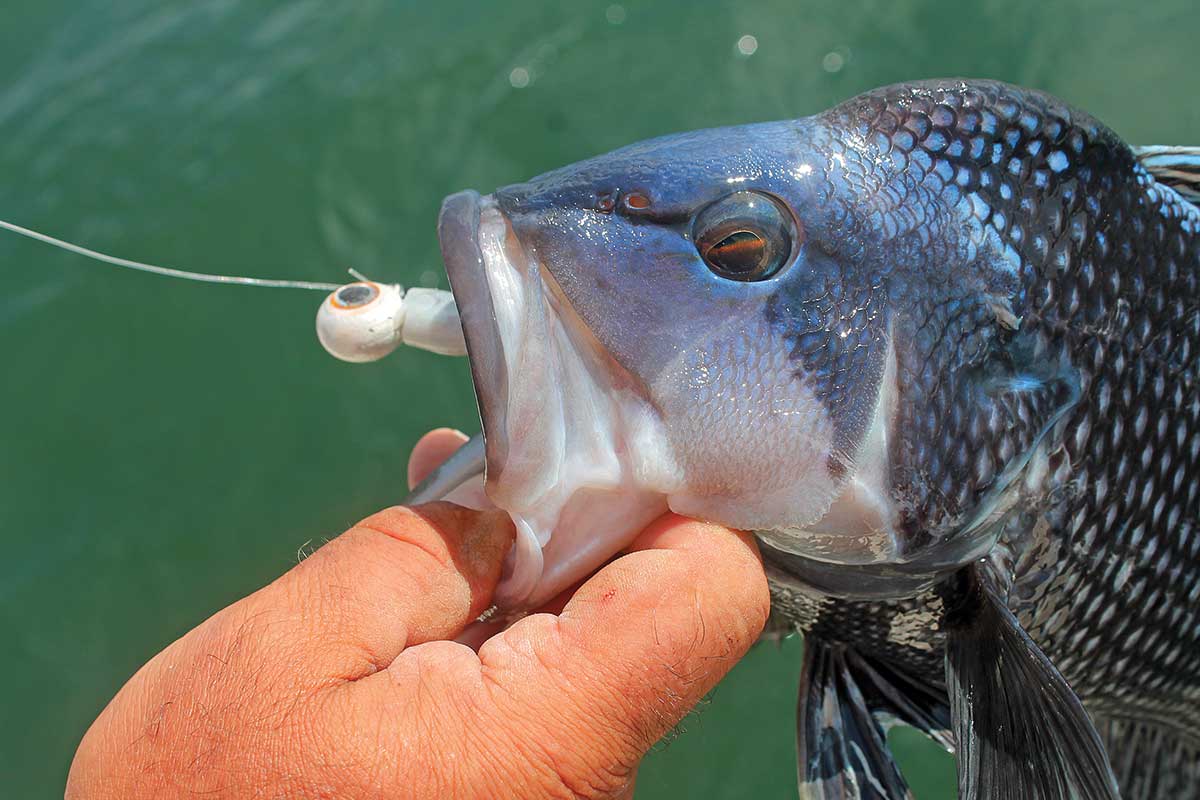
The waters off Long Island’s North Fork are prime habitat for big and feisty sea biscuits.
It was a beautiful late June morning last season when my buddy Ron Suda and I hit the waters outside of Mattituck Inlet where Ron keeps his 23-foot Aquasport at Charlie and Liz’s Mattituck Marina. The Sound was as flat as a mirror as we cleared the inlet and headed off to 45 feet of water off the Firing Range, just east of Mattituck Creek. “Mick and I had them here three days ago” shouted Ron. “With this heatwave, hopefully they didn’t move deeper.” As Ron eased off the throttle our eyes became focused on the fishfinder. Aside from the clutter of a few rocks, the recorder didn’t leave us feeling very optimistic as it was evident that the sea bass had moved for deeper cooler waters. A couple of short drifts proved the recorder wasn’t malfunctioning, so the hunt was on. Finally after an hour and a half with nothing but two sea robins and one short biscuit to show for our effort, Ron hit one of his rockpiles in 110 feet of water where it was game on for the next two hours as we enjoyed lock and load action with sea bass between 3 and 4-3/4 pounds. Except for our three per man limit, Ron and I safely released close to 30 other monsters, and logging some solid memories.
Spring Through Fall
By mid-May sea bass of this caliber are common off the shallow rocky shorelines east and west of Mattituck Inlet. Although possessing sea bass is not permitted until June 23, anglers in pursuit of big Mattituck fluke often are left with the heartbreak of releasing many jumbos in a day of fluking. By the time sea bass season debuts, the fish have spread out in the deep water of the Sound, making the hunt a bit more challenging. Optimistically however, when you find some rockpiles in the right depth of water sea bass have settled in, you can usually count on some wild fishing. In addition, good things happen to those who wait and those who wait until November will be delighted to know that the sea bass again return to the same shallower waters as in spring. Most of the action through the middle of the month takes place in 25 to 40 feet of water where anglers can put a seven fish per man bag limit of the tasty indigo jumbos in the box if they wish.
A good eye and a good navigational chart can potentially bring opportunities to savvy anglers in the form of honey holes that they can truly call their own. Sure charts are paramount to plot courses. These days fancy electronics contacting the satellites have shaved off much of the mathematics involve in plotting. Call me old fashioned but I still prefer to break out the paper charts to “read” the water. There’s a lot of ground out there and by examining a chart, you can get a detailed idea and pin point strong potential fishing spots, whether it be seeking out sea bass or any variety of bottom feeders. It is especially beneficial to study a chart before heading out to an area you are not familiar with and fishing for the first time. Look for deep-water high spots, rock bottoms and especially areas marked off with some form of structure or wrecks. Many of the wrecks marked on Long Island Sound nautical charts have been silted over or have broken apart. Nonetheless, exploring these areas will often give up a bit of debris that will hold giant sea bass and scup.
Easy Access

bass.
If you don’t keep a boat or know anyone who keeps a boat in one of the marinas in the creeks of Mattituck, anyone with a boat on a trailer will find a DEC State Ramp site that is just minutes away from Mattituck Inlet. The Mattituck Creek Waterway Access Site is the third and largest boat launch site operated by the DEC to provide public access to the waters of Long Island Sound. The facility features a two-lane ramp so that two boats can be launched/retrieved at the same time. Parking is available for up to 60 cars and trailers. There is a fishing pier and a separate dock designated for kayaks and canoes. The facility also features picnic tables, privies, interpretive materials, wildlife viewing and loading docks. All features are accessible to people with disabilities. The entrance to the facility and main gate is open to the public 24/7.
To get to this site take Sound Avenue east through the Town of Riverhead. At the first traffic light in Mattituck, turn left onto Cox Neck Lane. Stay on Cox Neck Lane to Breakwater Road, turn left, follow to Naugles Road and turn right, entrance is one-quarter mile down on the left side. A word of advice; make sure your vehicle and trailer are registered and inspected, otherwise there will be a Town of Southold summons or two under the windshield wiper.
Drifting until you locate a batch of biscuits is the best approach to putting a catch of tasty biscuits in the box when fishing the North Fork. The beauty of fishing east of Mattituck is that the rocky bottom areas here are much more forgiving than most rocky terrain, making it easy to wiggle out of a snag. Drifting is the way to go, especially when presenting artificial jigs. Fishing hi/low sinker rigs baited with fresh skimmer clams or squid strips will catch knot head biscuits, but you will also stand a much better chance of getting hung up in the rocks than you will when working a jig or bucktail.
Jig ‘em Up
Sea bass are not finicky when it comes to viciously attacking jigs. Shimano’s Lucanus jig has become a standard for anglers who take their sea bass jigging seriously. It features an aerodynamic head design dressed with a silicon skirt that lets it sink quickly to the bottom and stabilizes the jig when it is retrieved. It also incorporates a multi-hook system to provide a higher hook-up ratio. I’ve also had a lot of success with sea bass on Shimano’s Butterfly “Flat-Side” jigs, which are designed to perform specifically for vertical jigging from a drifting boat.
Another top choice for sea bass is Tsunami’s Facet jig. These high visibility jigs can be danced off the bottom for strike-triggering action. Glowing tentacles in the silicone skirt provide a tempting target for fish in heavy structure. Light-catching 3D eyes for a realistic look and scaled holographic finish (except on the glow jig) add to their visibility. The facet jigs have a natural tendency to circle as they are retrieved, allowing them to move laterally as well as vertically to cover a bit more water. If you prefer diamond jigs, you can’t go wrong with Marathon jigs. Their sleek aqua-dynamic design and durable triple chrome plating makes them one of the better quality diamond jigs on the market.
If you want some shake, rattle and roll included in your arsenal, check out the Raging Rattler from S & S Bucktails. The Raging Rattler has a full glow head and skirt but also an internal rattle that at times seems to draw strikes when other lures don’t. Also in the S&S lineup are the Octopi and Flutter jigs. Both are must-haves if you take jigging sea bass and fluke seriously.

Most would agree that baitcasters and conventional outfits in the 20-pound class are best suited for the task at hand. You’ll appreciate a combo light enough not to cause fatigue from jigging all day, yet strong enough to handle those jumbo knot heads. Whatever outfit you choose, an 8-foot shock leader, preferably fluorocarbon of 20-pound test, should be tied to the main line via an Albright knot. I like the old, reliable improved clinch knot to connect your lure of choice. Although the Lucanus and butterfly jigs are effective on their own, lures such the Raging Rattler, the Facet and diamond jigs can use a bit of enticement in the form of Berkley’s Gulp Alive. To make them even more effective, stock up on the 5-inch Gulp Alive swimming mullet in nuclear chicken, chartreuse and new penny.
When fishing jigs over scattered rocks, mussel, clam or oyster beds, jig along the bottom with a 1-foot lift and a steady bounce. Where hard structure is involved, you want to let the jig touch bottom, then put a couple of turns on the handle of the reel and glide the jig just above any structure you may be going over, including big boulders. If using artificials for sea bass is new to you, it will take getting used to the feel of bites and just banging against rocks. And if you stray off the bottom, know that sea bass have great eyesight and are very aggressive, venturing well off the bottom for something of interest. Jumbo bass will hit a lure like a freight train, so hold on tight to that rod.
Watch the Weather
Although Long Island Sound can be as flat as a lake, it can also become quite lumpy, and even dangerous for small boats. Since some of the hotspots are a six- or seven-mile hike from Mattituck Inlet, getting to and from the inlet can become a challenge when the Sound kicks up. Be sure to check out NOAA weather reports for sea conditions and wind velocity. Keep in mind that winds from both the north and east will produce tight chops against hard moving currents, whereas a southwest breeze should make for calmer seas.
It should be another banner year for jumbo sea bass off Mattituck this season so get out there for your share of the bounty. Just remember that a cooler full of fish does not equate to a good day. Please practice self-restraint so we can keep this fine fishery healthy and strong for years to come.

